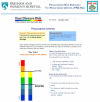Communicating genetic risk information for common disorders in the era of genomic medicine
- PMID: 24003856
- PMCID: PMC3862080
- DOI: 10.1146/annurev-genom-092010-110722
Communicating genetic risk information for common disorders in the era of genomic medicine
Abstract
Communicating genetic risk information in ways that maximize understanding and promote health is increasingly important given the rapidly expanding availability and capabilities of genomic technologies. A well-developed literature on risk communication in general provides guidance for best practices, including presentation of information in multiple formats, attention to framing effects, use of graphics, sensitivity to the way numbers are presented, parsimony of information, attentiveness to emotions, and interactivity as part of the communication process. Challenges to communicating genetic risk information include deciding how best to tailor it, streamlining the process, deciding what information to disclose, accepting that communications may have limited influence, and understanding the impact of context. Meeting these challenges has great potential for empowering individuals to adopt healthier lifestyles and improve public health, but will require multidisciplinary approaches and collaboration.
Figures




Similar articles
-
The future of Cochrane Neonatal.Early Hum Dev. 2020 Nov;150:105191. doi: 10.1016/j.earlhumdev.2020.105191. Epub 2020 Sep 12. Early Hum Dev. 2020. PMID: 33036834
-
Communicating genetic and genomic information: health literacy and numeracy considerations.Public Health Genomics. 2011;14(4-5):279-89. doi: 10.1159/000294191. Epub 2010 Apr 20. Public Health Genomics. 2011. PMID: 20407217 Free PMC article.
-
Public preferences for communicating personal genomic risk information: a focus group study.Health Expect. 2016 Dec;19(6):1203-1214. doi: 10.1111/hex.12406. Epub 2015 Sep 1. Health Expect. 2016. PMID: 26332492 Free PMC article.
-
Unintended Effects of Communicating About Drug Safety Issues: A Critical Review of the Literature.Drug Saf. 2019 Oct;42(10):1125-1134. doi: 10.1007/s40264-019-00840-3. Drug Saf. 2019. PMID: 31152320 Review.
-
Anticipating dissemination of cancer genomics in public health: a theoretical approach to psychosocial and behavioral challenges.Ann Behav Med. 2007 Nov-Dec;34(3):275-86. doi: 10.1007/BF02874552. Ann Behav Med. 2007. PMID: 18020937 Review.
Cited by
-
Enhancing genomic laboratory reports from the patients' view: A qualitative analysis.Am J Med Genet A. 2015 Oct;167A(10):2238-43. doi: 10.1002/ajmg.a.37174. Epub 2015 Jun 18. Am J Med Genet A. 2015. PMID: 26086630 Free PMC article.
-
Systemic lupus erythematosus as a genetic disease.Clin Immunol. 2022 Mar;236:108953. doi: 10.1016/j.clim.2022.108953. Epub 2022 Feb 9. Clin Immunol. 2022. PMID: 35149194 Free PMC article.
-
Sickle cell carriers' unmet information needs: Beyond knowing trait status.J Genet Couns. 2019 Aug;28(4):812-821. doi: 10.1002/jgc4.1124. Epub 2019 Apr 10. J Genet Couns. 2019. PMID: 30969464 Free PMC article.
-
Counselees' Perspectives of Genomic Counseling Following Online Receipt of Multiple Actionable Complex Disease and Pharmacogenomic Results: a Qualitative Research Study.J Genet Couns. 2017 Aug;26(4):738-751. doi: 10.1007/s10897-016-0044-9. Epub 2016 Dec 5. J Genet Couns. 2017. PMID: 27921197 Free PMC article.
-
Pathogen reduction/inactivation of products for the treatment of bleeding disorders: what are the processes and what should we say to patients?Ann Hematol. 2017 Aug;96(8):1253-1270. doi: 10.1007/s00277-017-3028-4. Epub 2017 Jun 18. Ann Hematol. 2017. PMID: 28624906 Free PMC article. Review.
References
-
- Alzheimer’s Assoc. Alzheimer’s disease facts and figures. Alzheimer’s Dement. 2012;8:131–68. - PubMed
-
- Am. Board Genet. Couns. (ABGC) About ABGC. 2013. http://www.abgc.net/About_ABGC/GeneticCounselors.asp.
-
- Am. Board Med. Genet. Number of certified specialists in genetics. 2011. http://www.abmg.org/pages/resources_certspecial.shtml.
-
- Armstrong K, Weiner J, Weber B, Asch DA. Early adoption of BRCA1/2 testing: who and why. Genet. Med. 2003;5:92–98. - PubMed
Publication types
MeSH terms
Grants and funding
- F32 HG006993/HG/NHGRI NIH HHS/United States
- K24AG027841/AG/NIA NIH HHS/United States
- R01HG005092/HG/NHGRI NIH HHS/United States
- P60 AR047782/AR/NIAMS NIH HHS/United States
- R01 HG002213/HG/NHGRI NIH HHS/United States
- R01 HG005092/HG/NHGRI NIH HHS/United States
- K24AR052403/AR/NIAMS NIH HHS/United States
- P60AR047782/AR/NIAMS NIH HHS/United States
- R01HG002213/HG/NHGRI NIH HHS/United States
- F32HG006993/HG/NHGRI NIH HHS/United States
- U01HG006500/HG/NHGRI NIH HHS/United States
- K24 AR052403/AR/NIAMS NIH HHS/United States
- R01AR049880/AR/NIAMS NIH HHS/United States
- K24 AG027841/AG/NIA NIH HHS/United States
- R01 AR049880/AR/NIAMS NIH HHS/United States
- U01 HG006500/HG/NHGRI NIH HHS/United States
LinkOut - more resources
Full Text Sources
Other Literature Sources

